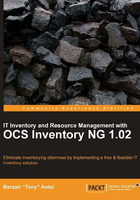
Summary
In this chapter, we learnt how to set up the OCS-NG management server. At first, we examined the architectural requirements of the server. We understood how the central management server is composed out of four components: communication server, database server, deployment server, and administration console.
The management server can be installed on Linux distributions and Microsoft Windows operating systems. We were required to get into package management systems and learn how to deal with packages and dependencies. This is usually tricky, and unfortunately, some people have had their share of bad experience equivalent to dependency hell.
Once we got to know some of the most popular package management systems, we could then set up the required AMP stack solution rather easily. This web server served as the foundation of the OCS-NG server.
Enthusiastically, as we were fulfilling the prerequisite checks, we moved on to install the OCS-NG management server. We have looked into two possible modalities on how to do this on Linux and one integrated solution to do this on Windows. We made sure that regardless of our chosen platform, the server got up and running with flying colors.
Now that we have finally put together our OCS-NG management server, it's time to get familiar with agent deployment. Agents will fill our inventory with useful data. After all, that is what inventorying is about—retrieving and storing data. By now, we have a centralized place to store data. Let's move on to learn how to deploy clients to gather data.